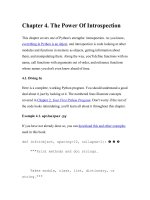Learning python design patterns leverage the power of python design patterns to solve real world problems in software architecture and design
Bạn đang xem bản rút gọn của tài liệu. Xem và tải ngay bản đầy đủ của tài liệu tại đây (3.22 MB, 164 trang )
Learning Python Design
Patterns
Second Edition
Leverage the power of Python design patterns to solve
real-world problems in software architecture and design
Chetan Giridhar
BIRMINGHAM - MUMBAI
Learning Python Design Patterns
Second Edition
Copyright © 2016 Packt Publishing
All rights reserved. No part of this book may be reproduced, stored in a retrieval
system, or transmitted in any form or by any means, without the prior written
permission of the publisher, except in the case of brief quotations embedded in
critical articles or reviews.
Every effort has been made in the preparation of this book to ensure the accuracy
of the information presented. However, the information contained in this book is
sold without warranty, either express or implied. Neither the author, nor Packt
Publishing, and its dealers and distributors will be held liable for any damages
caused or alleged to be caused directly or indirectly by this book.
Packt Publishing has endeavored to provide trademark information about all of the
companies and products mentioned in this book by the appropriate use of capitals.
However, Packt Publishing cannot guarantee the accuracy of this information.
First published: November 2013
Second edition: February 2016
Production reference: 1080216
Published by Packt Publishing Ltd.
Livery Place
35 Livery Street
Birmingham B3 2PB, UK.
ISBN 978-1-78588-803-8
www.packtpub.com
Credits
Author
Chetan Giridhar
Reviewer
Maurice HT Ling
Commissioning Editor
Kunal Parikh
Acquisition Editor
Denim Pinto
Content Development Editor
Merint Thomas Mathew
Technical Editor
Chinmay S. Puranik
Copy Editor
Tasneem Fatehi
Project Coordinator
Suzanne Coutinho
Proofreader
Safis Editing
Indexer
Priya Sane
Graphics
Kirk D'Penha
Production Coordinator
Shantanu N. Zagade
Cover Work
Shantanu N. Zagade
Foreword
"Controlling complexity is the essence of computer programming."
– Brian Kernighan
"All problems in computer science can be solved by another level of indirection
(abstraction)."
– David Wheeler
The preceding two quotes by two well known computer scientists illustrate the
problem faced by the modern software designer—coming up with a good, stable,
reusable, flexible solution to a software design problem.
Design patterns solve the preceding problems in the most elegant way. Design
patterns abstract and present in neat, well-defined components and interfaces the
experience of many software designers and architects over many years of solving
similar problems. These are solutions that have withstood the test of time with
respect to reusability, flexibility, scalability, and maintainability.
There have been many books on design patterns with the well-known Gang of Four
(GoF) book forming the cornerstone of nearly the entire domain.
However, in this era of web and mobile computing, where programs tend to
get written in high-level languages such as Python, Ruby, and Clojure, there is
often a need for books that translate the rather esoteric language used in such
books into more familiar terms, with reusable code written in these newer, more
dynamic programming languages. This is especially true when it comes to newbie
programmers who often tend to get lost in the complexities of design versus
implementation and often require an expert helping hand.
This book fulfills that role very well. It uses the template of design patterns as laid
out in the GoF book and adds a few others as well for completion—but before
jumping into the patterns itself, gives the young and inexperienced reader the
fundamentals of software design principles that have gone into the thinking behind
the creation and evolution of these design patterns. It doesn't walk the gentle reader
blindly into the maze of the pattern world, but lays out the fundamentals well before
opening that door and carrying the reader along that path of learning.
The book is written with Python as the language for implementing the sample
code for the patterns—and this makes excellent sense. As someone who has spent
more than 12 years in the company of this wonderful programming language, I can
attest to its beauty and simplicity and its effectiveness in solving problems ranging
from routine to the most complex. Python is ideally suited to the rookie and young
programmer, and with the ease of learning it, it is also a lot of fun to code in. The
young programmer would find their time spent in the company of Python along in
this book very rewarding and fruitful.
Chetan Giridhar has been working and contributing to Python for well over 7 years.
He is ideally suited for the job of penning a book like this, as he has gone through
some of the cycles of learning the complexities of implementation and design
himself and has learned well through that process. He is a well-known speaker
on a number of varied topics in Python and has delivered well-attended talks at
Python conferences, such as PyCon India. He was amongst the invited speakers for
conferences in the USA, Asia-Pacific, and New Zealand.
I believe this book, Learning Python Design Patterns, Second Edition, would be an
excellent addition to the Learning series by Packt Publishing and would provide
a set of skills to the toolbox of the young Python programmer that would take
them gently and expertly to being able to design modular and efficient programs
in Python.
Anand B Pillai
CTO—Skoov.com
Board Member—Python Software Foundation
Founder—Bangalore Python User's Group
About the Author
Chetan Giridhar is a technology leader, open source enthusiast, and Python
developer. He has written multiple articles on technology and development practices
in magazines such as LinuxForYou and Agile Record, and has published technical
papers in the Python Papers journal. He has been a speaker at PyCon conferences
such as PyCon India, Asia-Pacific, and New Zealand and loves working on real-time
communications, distributed systems, and cloud applications. Chetan has been a
reviewer at Packt Publishing and has contributed to books on IPython Visualizations
and Core Python.
I'd like to thank the Packt Publishing team, especially Merint
Thomas Mathew, and the technical reviewer, Maurice HT Ling,
for bringing out the best content in this book. Special thanks to my
mentor, Anand B Pillai, for graciously accepting to review this book
and writing the foreword. This book wouldn't be possible without
the blessings of my parents, Jyotsana and Jayant Giridhar, and
constant support and encouragement from my wife, Deepti,
and my daughter, Pihu!
About the Reviewer
Maurice HT Ling has been programming in Python since 2003. Having completed
his Ph D in bioinformatics and B Sc (honors) in molecular and cell biology from The
University of Melbourne, he is currently a research fellow in Nanyang Technological
University, Singapore, and an honorary fellow at The University of Melbourne,
Australia. Maurice is the chief editor for computational and mathematical biology,
and co-editor for The Python Papers. Recently, Maurice cofounded the first
synthetic biology startup in Singapore, AdvanceSyn Pte. Ltd., as a director and chief
technology officer. He is also the principal partner of Colossus Technologies LLP,
Singapore. His research interests lie in life—biological life, artificial life, and artificial
intelligence—using computer science and statistics as tools to understand life and
its numerous aspects. In his free time, Maurice likes to read, enjoy a cup of coffee,
write his personal journal, or philosophize on various aspects of life. You can reach
him at his website and on his LinkedIn profile at and
respectively.
www.PacktPub.com
Support files, eBooks, discount offers, and more
For support files and downloads related to your book, please visit www.PacktPub.com.
Did you know that Packt offers eBook versions of every book published, with PDF
and ePub files available? You can upgrade to the eBook version at www.PacktPub.com
and as a print book customer, you are entitled to a discount on the eBook copy. Get in
touch with us at for more details.
At www.PacktPub.com, you can also read a collection of free technical articles, sign
up for a range of free newsletters and receive exclusive discounts and offers on Packt
books and eBooks.
TM
/>
Do you need instant solutions to your IT questions? PacktLib is Packt's online digital
book library. Here, you can search, access, and read Packt's entire library of books.
Why subscribe?
• Fully searchable across every book published by Packt
• Copy and paste, print, and bookmark content
• On demand and accessible via a web browser
Free access for Packt account holders
If you have an account with Packt at www.PacktPub.com, you can use this to access
PacktLib today and view 9 entirely free books. Simply use your login credentials for
immediate access.
Table of Contents
Prefacevii
Chapter 1: Introduction to Design Patterns
1
Understanding object-oriented programming
2
Objects2
Classes2
Methods3
Major aspects of object-oriented programming
3
Encapsulation
3
Polymorphism4
Inheritance4
Abstraction5
Composition6
Object-oriented design principles
6
The open/close principle
6
The inversion of control principle
7
The interface segregation principle
7
The single responsibility principle
8
The substitution principle
8
The concept of design patterns
8
Advantages of design patterns
10
Taxonomy of design patterns
10
Context – the applicability of design patterns
10
[i]
Table of Contents
Patterns for dynamic languages
11
Classifying patterns
11
Creational patterns
11
Structural patterns
12
Behavioral patterns
12
Summary12
Chapter 2: The Singleton Design Pattern
13
Chapter 3: The Factory Pattern – Building Factories
to Create Objects
25
Chapter 4: The Façade Pattern – Being Adaptive with Façade
39
Understanding the Singleton design pattern
14
Implementing a classical Singleton in Python
14
Lazy instantiation in the Singleton pattern
15
Module-level Singletons
16
The Monostate Singleton pattern
16
Singletons and metaclasses
18
A real-world scenario – the Singleton pattern, part 1
19
A real-world scenario – the Singleton pattern, part 2
21
Drawbacks of the Singleton pattern
23
Summary24
Understanding the Factory pattern
25
The Simple Factory pattern
26
The Factory Method pattern
28
Implementing the Factory Method
29
Advantages of the Factory method pattern
32
The Abstract Factory pattern
32
Implementing the Abstract Factory pattern
34
The Factory method versus Abstract Factory method
36
Summary37
Understanding Structural design patterns
40
Understanding the Façade design pattern
40
A UML class diagram
41
Façade42
System42
Client43
Implementing the Façade pattern in the real world
43
The principle of least knowledge
47
Frequently asked questions
47
Summary48
[ ii ]
Table of Contents
Chapter 5: The Proxy Pattern – Controlling Object Access
49
Chapter 6: The Observer Pattern – Keeping Objects in the Know
61
Chapter 7: The Command Pattern – Encapsulating Invocation
73
Understanding the Proxy design pattern
A UML class diagram for the Proxy pattern
Understanding different types of Proxies
A virtual proxy
A remote proxy
A protective proxy
A smart proxy
The Proxy pattern in the real world
Advantages of the Proxy pattern
Comparing the Façade and Proxy patterns
Frequently asked questions
Summary
50
52
53
53
53
54
54
54
58
58
58
59
Introducing Behavioral patterns
62
Understanding the Observer design pattern
62
A UML class diagram for the Observer pattern
64
The Observer pattern in the real world
65
The Observer pattern methods
69
The pull model
69
The push model
70
Loose coupling and the Observer pattern
70
The Observer pattern – advantages and disadvantages
71
Frequently asked questions
71
Summary72
Introducing the Command pattern
74
Understanding the Command design pattern
74
A UML class diagram for the Command pattern
76
Implementing the Command pattern in the real world
79
Design considerations
79
Advantages and disadvantages of Command patterns
83
Frequently asked questions
83
Summary84
[ iii ]
Table of Contents
Chapter 8: The Template Method Pattern – Encapsulating
Algorithm85
Defining the Template Method pattern
Understanding the Template Method design pattern
A UML class diagram for the Template Method pattern
The Template Method pattern in the real world
The Template Method pattern – hooks
The Hollywood principle and the Template Method
The advantages and disadvantages of the Template Method pattern
Frequently asked questions
Summary
Chapter 9: Model-View-Controller – Compound Patterns
86
88
90
92
96
97
97
98
98
99
An introduction to Compound patterns
100
The Model-View-Controller pattern
100
Model – knowledge of the application
102
View – the appearance
103
Controller – the glue
103
A UML class diagram for the MVC design pattern
105
The MVC pattern in the real world
107
Modules107
Benefits of the MVC pattern
114
Frequently asked questions
115
Summary115
Chapter 10: The State Design Pattern
117
Defining the State design pattern
117
Understanding the State design pattern
118
Understanding the State design pattern with a UML diagram
120
A simple example of the State design pattern
120
The State design pattern with v3.5 implementation
122
Advantages/disadvantages of the State pattern
125
Summary126
[ iv ]
Table of Contents
Chapter 11: AntiPatterns127
An introduction to AntiPatterns
128
Software development AntiPatterns
129
Spaghetti code
129
Golden Hammer
130
Lava Flow
131
Copy-and-paste or cut-and-paste programming
131
Software architecture AntiPatterns
132
Reinventing the wheel
132
Vendor lock-in
133
Design by committee
133
Summary134
Index135
[v]
Preface
Design patterns are among the most powerful methods of building large software
systems. With an increasing focus on optimized software architecture and design,
it is important that software architects think about optimizations in object creation,
code structure, and interaction between objects at the architecture or design level.
This makes sure that the cost of software maintenance is low, and code can be easily
reused and is adaptable to change. Moreover, providing frameworks for reusability
and separation of concerns is key to software development today.
What this book covers
Chapter 1, Introduction to Design Patterns, goes through the basics of object-oriented
programming and discusses object-oriented design principles in detail. This chapter
gives a brief introduction to the concept of design patterns so that you will be able to
appreciate the context and application of design patterns in software development.
Chapter 2, The Singleton Design Pattern, covers one of the simplest and well-known
Creational design patterns used in application development—the Singleton design
pattern. The different ways in which we can create a Singleton pattern in Python
are also covered in this chapter along with examples. This chapter also covers the
Monostate (or Borg) design pattern, which is a variant of the Singleton design pattern.
Chapter 3, The Factory Pattern – Building Factories to Create Objects, discusses another
creational pattern, the Factory pattern. You will also learn about the Factory Method
pattern and Abstract Factory pattern with a UML diagram, real-world scenarios, and
Python v3.5 implementations.
[ vii ]
Preface
Chapter 4, The Façade Pattern – Being Adaptive with Façade, shows you another type of
design pattern, the Structural design pattern. We will be introduced to the concept of
Façade and learn how it is applicable to software design with the help of the Façade
design pattern. You'll also learn its implementation with a sample Python application
using a real-world scenario.
Chapter 5, The Proxy Pattern – Controlling Object Access, deals with the Proxy pattern
that falls into the category of Structural design patterns. We will be introduced to the
Proxy as a concept and discuss the design pattern and see how it is used in software
application development. You'll also learn about the different variants of the Proxy
pattern—Virtual Proxy, Smart Proxy, Remote Proxy, and Protective Proxy.
Chapter 6, The Observer Pattern – Keeping Objects in the Know, talks about the third
type of design pattern—the behavioral design pattern. We will be introduced to
the Observer design pattern with examples. In this chapter, you'll learn how to
implement the Push and Pull models of the Observer pattern and the principles of
loose coupling. We'll also see how this pattern is critical when it comes to applying it
to cloud applications and distributed systems.
Chapter 7, The Command Pattern – Encapsulating Invocation, tells you about the
Command design pattern. We will be introduced to the Command design pattern
and discuss how it is used in software application development with a realworld scenario and Python implementation. We will also study two main aspects
of the Command pattern—an implementation of redo/rollback operations and
asynchronous task execution.
Chapter 8, The Template Method Pattern – Encapsulating Algorithm, discusses the
Template design pattern. Like the Command pattern, the Template pattern falls into
the category of Behavioral patterns. Here, we discuss the Template method pattern,
and you will learn about Hooks with an implementation. We'll also cover the
Hollywood principle that helps us appreciate this pattern better.
Chapter 9, Model-View-Controller – Compound Patterns, talks about Compound
patterns. We will be introduced to the Model-View-Controller design pattern and
discuss how it is used in software application development. MVC is easily one of
the most used design patterns; in fact, many Python frameworks are based on this
principle. You will learn about the details of MVC implementation with an example
application written in Python Tornado (a framework used by Facebook).
Chapter 10, The State Design Pattern, introduces you to the State design pattern, which
falls into the category of Behavioral patterns just like the Command or Template
design patterns. We will discuss how it is used in software application development.
Chapter 11, AntiPatterns, tells you about AntiPatterns—what we shouldn't do as
architects or software engineers.
[ viii ]
Preface
What you need for this book
All you need is Python v3.5, and you can download it from
/>
Who this book is for
This book is for Python developers and software architects who care about software
design principles and details of application development aspects in Python. It
requires a basic understanding of programming concepts and beginner-level Python
development experience. It will also be helpful for students and teachers in live
learning environments.
Conventions
In this book, you will find a number of text styles that distinguish between different
kinds of information. Here are some examples of these styles and an explanation of
their meaning.
Code words in text, database table names, folder names, filenames, file extensions,
pathnames, dummy URLs, user input, and Twitter handles are shown as follows:
"The Car object will have attributes such as fuel level, isSedan, speed, and
steering wheel and coordinates."
A block of code is set as follows:
class Person(object):
def __init__(self, name, age): #constructor
self.name = name
#data members/ attributes
self.age = age
def get_person(self,):
# member function
return "<Person (%s, %s)>" % (self.name, self.age)
p = Person("John", 32)
# p is an object of type Person
print("Type of Object:", type(p), "Memory Address:", id(p))
[ ix ]
Preface
New terms and important words are shown in bold. Words that you see on the
screen, for example, in menus or dialog boxes, appear in the text like this: "In Python,
the concept of encapsulation (data and method hiding) is not implicit, as it doesn't
have keywords such as public, private, and protected (in languages such as C++ or
Java) that are required to support encapsulation."
Warnings or important notes appear in a box like this.
Tips and tricks appear like this.
Reader feedback
Feedback from our readers is always welcome. Let us know what you think about
this book—what you liked or disliked. Reader feedback is important for us as it helps
us develop titles that you will really get the most out of.
To send us general feedback, simply e-mail , and mention
the book's title in the subject of your message.
If there is a topic that you have expertise in and you are interested in either writing
or contributing to a book, see our author guide at www.packtpub.com/authors.
Customer support
Now that you are the proud owner of a Packt book, we have a number of things to
help you to get the most from your purchase.
Downloading the example code
You can download the example code files from your account at http://www.
packtpub.com for all the Packt Publishing books you have purchased. If you
purchased this book elsewhere, you can visit />and register to have the files e-mailed directly to you.
[x]
Preface
Errata
Although we have taken every care to ensure the accuracy of our content, mistakes
do happen. If you find a mistake in one of our books—maybe a mistake in the text or
the code—we would be grateful if you could report this to us. By doing so, you can
save other readers from frustration and help us improve subsequent versions of this
book. If you find any errata, please report them by visiting ktpub.
com/submit-errata, selecting your book, clicking on the Errata Submission Form
link, and entering the details of your errata. Once your errata are verified, your
submission will be accepted and the errata will be uploaded to our website or added
to any list of existing errata under the Errata section of that title.
To view the previously submitted errata, go to />content/support and enter the name of the book in the search field. The required
information will appear under the Errata section.
Piracy
Piracy of copyrighted material on the Internet is an ongoing problem across all
media. At Packt, we take the protection of our copyright and licenses very seriously.
If you come across any illegal copies of our works in any form on the Internet, please
provide us with the location address or website name immediately so that we can
pursue a remedy.
Please contact us at with a link to the suspected
pirated material.
We appreciate your help in protecting our authors and our ability to bring you
valuable content.
Questions
If you have a problem with any aspect of this book, you can contact us at
, and we will do our best to address the problem.
[ xi ]
Introduction to
Design Patterns
In this chapter, we will go through the basics of object-oriented programming and
discuss the object-oriented design principles in detail. This will get us prepared for
the advanced topics covered later in the book. This chapter will also give a brief
introduction to the concept of design patterns so that you will be able to appreciate
the context and application of design patterns in software development. Here we
also classify the design patterns under three main aspects—creational, structural, and
Behavioral patterns. So, essentially, we will cover the following topics in this chapter:
• Understanding object-oriented programming
• Discussing object-oriented design principles
• Understanding the concept of design patterns and their taxonomy
and context
• Discussing patterns for dynamic languages
• Classifying patterns—creational pattern, structural pattern,
and behavioral pattern
[1]
Introduction to Design Patterns
Understanding object-oriented
programming
Before you start learning about design patterns, it's always good to cover the basics
and go through object-oriented paradigms in Python. The object-oriented world
presents the concept of objects that have attributes (data members) and procedures
(member functions). These functions are responsible for manipulating the attributes.
For instance, take an example of the Car object. The Car object will have attributes
such as fuel level, isSedan, speed, and steering wheel and coordinates,
and the methods would be accelerate() to increase the speed and takeLeft() to
make the car turn left. Python has been an object-oriented language since it was first
released. As they say, everything in Python is an object. Each class instance or variable
has its own memory address or identity. Objects, which are instances of classes,
interact among each other to serve the purpose of an application under development.
Understanding the core concepts of object-oriented programming involves
understanding the concepts of objects, classes, and methods.
Objects
The following points describe objects:
• They represent entities in your application under development.
• Entities interact among themselves to solve real-world problems.
• For example, Person is an entity and Car is an entity. Person drives Car to
move from one location to the other.
Classes
Classes help developers to represent real-world entities:
• Classes define objects in attributes and behaviors. Attributes are data
members and behaviors are manifested by the member functions
• Classes consist of constructors that provide the initial state for these objects
• Classes are like templates and hence can be easily reused
For example, class Person will have attributes name and age and member function
gotoOffice() that defines his behavior for travelling to office for work.
[2]









